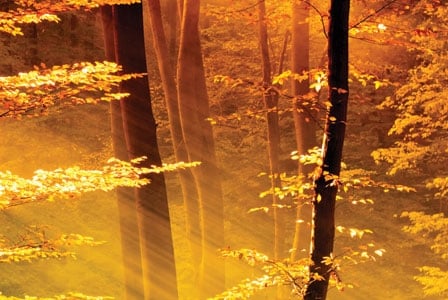
In Japan they call it Shinrin-yoku, translated literally as \”forest bathing.\” But are there scientifically supported health benefits to being in the forest?
In Japan they call it Shinrin-yoku, translated literally as “forest bathing.\” But are there scientifically supported health benefits to being in the forest?
Absolutely, according to a growing body of research from Japan.
Shinrin-yoku
A forest bathing trip involves spending a short, leisurely time in a forest setting, for the purpose of absorbing the forest’s healing ambience. Key to the experience is the inhalation of wood essential oils, similar to natural aromatherapy, but visual, auditory, and other sensory stimuli are also important.
The result? A host of health benefits, including a boosted immune system, an increase in cancer-battling proteins, and improved blood pressure, among others. Studies have also found psychological benefits, with forest bathers seeing significant increases in positive feelings and decreases in negative feelings.
It is fair to say, then, that forest bathing is good for both the body and the spirit, and while studies have so far found that some of these benefits only appear after subjects have spent two to three days in the forest, some benefits appear after a mere half hour.
To many Canadian hikers and nature lovers, these revelations will likely come as no surprise. To stroll a forest path or to sit peacefully in the woods is to understand implicitly the deep healing relaxation that forests can provide.
But with studies of Shinrin-yoku showing beneficial results from even short, mostly sedentary visits to the woods, forest bathing is now being viewed as a legitimate healing practice that Canadians of even limited mobility can enjoy and profit from.
A simple practice
Part of the beauty of forest bathing is its simplicity. Just being in the forest is enough to absorb the forest’s healing benefits. Bathers might walk at a relaxed pace or simply sit and gaze at the trees, inhaling the aroma of bark and needles, listening to wind stirring the leaves overhead, and letting the peace of the forest wash over them.
While forests lend themselves innately to quiet reflection, you do not need to spend your time there meditating or consciously relaxing—the forest will take care of that itself, bestowing its rewards through sight, sound, smell, and touch.
For best forest bathing practice, Dr. Qing Li, the foremost researcher in the area of forest bathing, recommends walking only a moderate distance on your bathing trips (2.5 km in two hours, 5 km in four), and he stresses that you should never overly tire yourself. If you need to rest, rest. If you need to drink, drink. If you wish to sit and read your book, do so. Forest bathing is about relaxing, so relax.
A perfect time for bathing
With deciduous leaves drifting down and woodland streams bulging with rainfall runoff, fall is a season of phenomenal woodland beauty. It is a time of quiet and peace and reflection, and despite the cooling temperatures and lengthening shadows, some of the most enjoyable forest visits can be had now, in the crispness of late fall.
Still, at this time of year it pays to prepare yourself for every eventuality. Be sure to check the weather forecast before heading out, as snow and rain can come up unexpectedly, and there is nothing relaxing about being wet and cold.
With this in mind, always bring appropriate clothing—a warm jacket, rain gear, water-resistant walking shoes—for whatever conditions are expected, and pack an extra layer just in case the weather person gets it wrong.
Thus equipped, you will find that fall is the perfect time for forest bathing. So get out there and ease into the natural, healing beauty. The forest is waiting.
Japanese research
In a recent Japanese study, researchers examined the physiological response of 280 subjects to relatively brief encounters with 24 forests. For each forest, six subjects spent approximately 30 minutes walking and gazing, while six others spent an equivalent amount of time in an urban area.
Those who were exposed to forest settings had greatly improved cortisol (stress) levels, pulse rates, blood pressure, and parasympathetic nerve activity levels versus those who were exposed to urban settings.
Related Japanese studies show similar benefits, from boosting intracellular anticancer proteins in female subjects to improving the body’s immune function naturally.
Forest safety
When heading out for a session of forest bathing (or on any trip to an isolated area), be sure to practise the following safety precautions:
- Make sure someone knows your itinerary and when you plan to return, and have a plan in place (who to call) if you don’t return on time.
- Familiarize yourself with a map of the park or forest, and routes to and from.
- Check the weather forecast and current park or trail conditions.
- Pack adequate food, water, and clothing.
- Carry a first aid kit.
- When possible, go in pairs or a group. This point is especially important if you are older or have problems with mobility.
Urban parks for forest bathing
While most rural Canadians have ample forest access, city dwellers must sometimes search a little harder. The following are a few forested areas that are easily accessible from Canada’s largest cities—Vancouver, Toronto, and Montreal—and are perfectly suited to forest bathing.
Vancouver: Pacific Spirit Regional Park
Over 750 hectares of pristine forest immediately west of Vancouver, near the University of British Columbia. vancouvertrails.com
Toronto: Morningside Park
Located in Scarborough, Morningside Park is a particularly wild Toronto-area park, making it ideal for forest bathing. toronto.ca
Montreal: Bois-de-Liesse Nature Park (parc-nature du Bois-de-Liesse)
A hardwood conservation forest in the heart of Montreal; home to the American beaver, the map turtle, and the flowering rush. bonjourquebec.com



